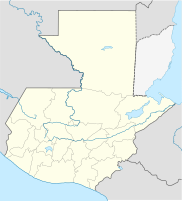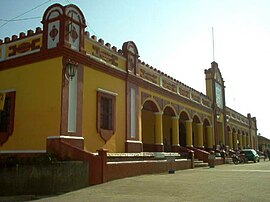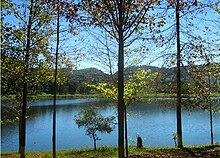San Cristóbal Verapaz
| San Cristóbal Verapaz | ||
|---|---|---|
|
Coordinates: 15 ° 22 ′ N , 90 ° 29 ′ W San Cristóbal Verapaz on the map of Guatemala
|
||
| Basic data | ||
| Country | Guatemala | |
| Department | Alta Verapaz | |
| City foundation | August 14, 1565 | |
| Residents | 54,704 (2008) | |
| Detailed data | ||
| surface | 192 km 2 | |
| Population density | 285 inhabitants / km 2 | |
| height | 1393 m | |
| Waters | Río Chixoy , Laguna Chichoj | |
| Post Code | 16003 | |
| Time zone | UTC −6 | |
| City patron | San Cristobal | |
| Coat of arms of San Cristóbal Verapaz | ||
| town hall | ||
San Cristóbal Verapaz is a small town in Guatemala and the administrative seat of the large municipality of the same name ( Municipio ) in the Alta Verapaz department . Around 55,000 people live in the 192 km² municipality.
geography
San Cristóbal Verapaz is located in the southwest of Alta Verapaz in the valley of the Río Chixoy at an altitude of about 1,400 m. The majority of the municipal area extends in the surrounding mountains, the highest peak of which reaches 2,220 m here. The municipality is characterized by cloud forest and a humid, temperate climate. The landscape is amazingly similar to the Central European foothills of the Alps . Immediately southeast of the main town of San Cristobal is the Laguna Chichoj , a scenic lake that has been heavily polluted by untreated sewage. A few kilometers further south, the Río Chixoy near Santa Ana ( Baja Verapaz / Quiché ) was dammed. The largest hydropower plant in Guatemala is located there .
San Cristóbal borders on the municipality of Cobán to the north and Santa Cruz Verapaz to the east . In the south and west, the wide arch of the Río Chixoy forms the border between the municipality and the Alta Verapaz department and the much drier neighboring Quiché district .
population
The majority of the population belongs to the Maya group of the Pocomchí . Their center in the Verapaz region is the Rabinal area in Baja Verapaz , and over time they expanded their settlement area to the southwest of Alta Verapaz. In addition to Spanish and Pocomchí, Kekchí is also spoken .
history
In the pre-colonial era, there was a settlement called Kab-Koj ("colorful big cat") on the territory of the municipality . The Dominicans , who penetrated the Verapaz region peacefully , founded San Cristóbal Verapaz on August 14, 1565 with the immigrant Pocomchí. In the 1970s and 1980s, the community suffered badly from the civil war .
Economy and Transport
San Cristóbal is located on the national road 7 running in west-east direction, which leads from Huehuetenango via Quiché and Alta Verapaz to Izabal . It is a very curvy country road of national importance, but large parts of it are in poor condition. San Cristóbal has long been considered the western gate of Alta Verapaz and therefore also a trading center (market). The national road 7 crosses a few kilometers east of San Cristóbal, at Santa Cruz Verapaz, the well-developed trunk road CA 14, which leads from Cobán to El Rancho ( El Progreso ). From there you can take the CA 9 motorway to Guatemala City in the highlands or to Puerto Barrios on the Caribbean coast. From San Cristóbal it is 211 km to Guatemala City and 29 km to Cobán, the capital of the Alta Verapaz department. On January 2, 2009, 31 people were killed in a landslide on National Road 7 near San Cristóbal.
The people in San Cristóbal Verapaz live mainly from agriculture, forestry and timber . Deforestation and hunting have caused significant damage to flora and fauna. There are a few industrial establishments, including a shoe factory. Tourism plays a subordinate role. Among the most important sights are the parish church, the celebrations during Holy Week ( Semana Santa ) and those in honor of the city patron Christophorus (San Cristóbal) from July 20th to 25th, as well as the small Katinamit museum, which presents the history of the local Pocomchí. The Laguna Chichoj is now part of a nature conservation project.
Web links
- Tourist information (Spanish)




